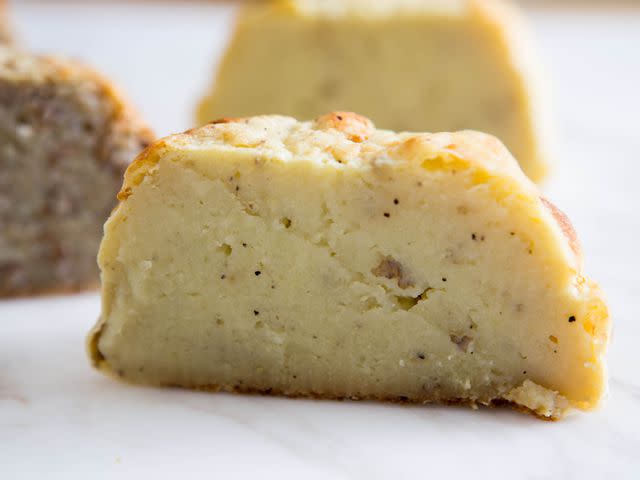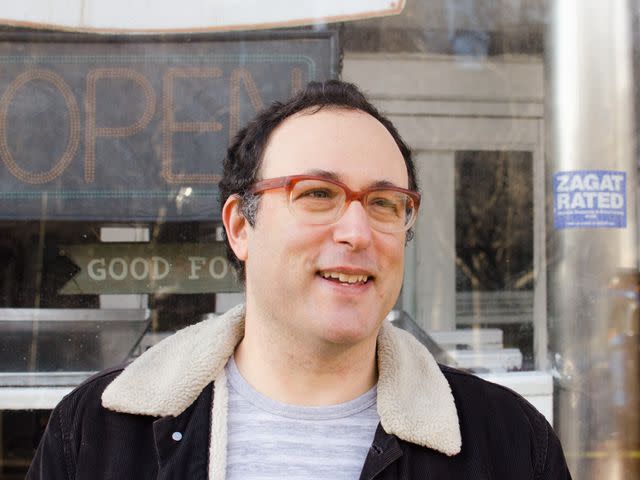Why the Knish Became New York's Miss Congeniality
Why Knishes are vital to Jews'—and New Yorkers'—culinary heritage, even if everyone else forgets.

Serious Eats / Max Falkowitz
A potato knish at the Lower East Side's Yonah Schimmel's."People used to say, 'the streets in New York are paved in gold,'" Laura Silver said to me over the phone. "No they're not. They're paved in knishes."
Born in Brooklyn and bred in Queens, Silver is the world's leading authority on the knish. And as the author of the authoritative and charming Knish: In Search of the Jewish Soul Food, she knows just how vital it is to Jews'—and New Yorkers'—culinary heritage, even if everyone else forgets about the poor thing.
A bomb of starchy fillings like nutty kasha groats or mashed potato with caramelized onions, wrapped in a thin sheet of dough and baked, the knish is claimed by Russians, Poles, and Ukrainians, and came to New York on the backs of Jewish immigrants. The way Silver sees it, the knish is a quintessential New York food, one that filled stomachs for pennies on the dollar and granted immigrants an economic opportunity to build a future for their children's children.

Serious Eats / Max Falkowitz
"[The knish] was a conduit to a better life and a different social status," Silver says. Knishes first started showing up on Lower East Side around 1910, when Yonah Schimmel reportedly opened on Houston Street. In 1916, the New York Times reported from the front lines of the Lower East Side's knish scene. In an early instance of Times reporting on the food, an article titled "Rivington St. Sees War" covered a long lost place called Max Green's, which it deemed "the originator of the great knish" and the first to sell it. Knisheries opened up wherever Jews moved, from Shatzkin's in Coney Island to Adelman's in Midwood to Knish Nosh in Forest Hills.
Silver's book is stuffed with anecdotes and historical notes that show just how important it was to Jewish life in New York. In its prime, she writes, the knish was a must-eat on the city's political circuit, a flag for any candidate to rally behind to demonstrate his support for the Jewish community. It was a Jewish pop culture muse, from Yiddish theater to comedy, where it was sometimes used as slang for women's genitals. It's all part of a tradition, Silver explains, that began with Jewish female comedians in the 1950s and continues to this day in the raunchy routines of Sarah Silverman.
New York still has its knisheries, but compared to the bagel and bialy, the knish just never made it big as a culinary icon. It appears in few guide books as a must-eat dish. Few people, these days, will kvell about a knish. That's a shame, as it deserves to be more than a historical footnote.

Serious Eats / Max Falkowitz
The knish, when it's done right, is just as delicious as the bagel. There's a filling of onions cooked to golden caramel in chicken fat, then painted onto a belly-hugging potato canvas. That carby mass is then wrapped in thin, pliant dough and blistered in the oven. It's great with deli mustard.
No, the knish is not sexy. It's brownish and rotund and anything but elegantly shaped. But it is food that will make you feel good, fill you up on the cheap before a long day of work, or sop up the pain of loss or an unexpected breakup.
Some New Yorkers believe that it's no longer easy—or possible—to get a good knish. Silver disagrees, and she makes a strong case with her "Where To Eat A Good Knish" map, which includes Judy's Knishes, established in 2014, among her growing list of 16 approved sources in the five boroughs. So why isn't the knish more popular?

Serious Eats / Vicky Wasik
Silver believes that the knish was a victim of its own success, arguing that knisheries gave immigrant Jews a living, if only meager, that allowed them to take the first steps up the social ladder. As upwardly mobile Jews left poor neighborhoods like the Lower East Side, the knisheries that boosted economies a generation ago lost business and eventually closed. New knisheries opened where Jewish communities landed: Long Beach on Long Island, Baldwin in Westchester, and elsewhere. The knish sustained itself, but didn't see breakout success like the bagel did.
As part of her efforts to spread the knish gospel, Silver started teaching classes on its history. At one such class, a Staten Island native named Noah Wildman showed up, finding in Silver a fellow obsessive. Wildman had gone to culinary school, worked at Brooklyn charmer Franny's, and once wanted to open up his own pizzeria. But he eventually ditched the slice to launch a brief-lived knishery in 2011.
Growing up, Wildman thought every American household stocked knishes. "It had never occurred to me that this wasn't something that was common from here to California and beyond," he says.

Serious Eats / Max Falkowitz
Like Silver, he grew up with Ms. Stahl's, because his mother was from Brooklyn. After his mother died, he returned there for the first time in years only to find the knishery had disappeared. He felt like he lost a part of his mother, the way one might if a family home is torn down. "That was how she fed me. Feeding me part of her own childhood, it connected us—I didn't appreciate it at the time, but now that it's gone it's so glaringly obvious."
People like Wildman and Silver attach a profound importance to the knish. To see why more people don't, I turned to Jim Leff, the founder of Chowhound and a retired food obsessive who once catalogued outer borough eats.
"Is there an expectation that foreign traditions ought to permeate our culture?" Leff asked back. "When something does make that jump that's the exception rather than the rule. But it's not like football play-offs; the worthiest don't make the cut via a series of trials. Stuff just sneaks in. One can trace why tacos did make it, but there's no explaining why knishes didn't. Yes, they're delicious, when right, but a great many things are delicious when right."

Serious Eats / Max Falkowitz
There might've been something else, though, that held the knish back. I reached out to Leff because of comments he made for a 2003 New York Times article about the disappearance of street knishes. The knishes in question are popularly known as the Coney Island knish, square-shaped and deep-fried specimens that are turmeric-yellow in color. They were invented on Forsyth Street on the Lower East Side in 1921 and continue to be produced by the family company, Gabila's, in Copiague in Suffolk County.
The company was very successful and their knishes became widespread in delis and at hot dog carts, so much so that when many modern New Yorkers say "knish," they mean Gabilla's. When the company's factory caught fire in 2013, alarmist headlines declared a knish shortage and famine.
But some, including Leff, just don't care for Gabilla's. As he tells it, these mass-produced knishes are pretenders to the throne, which by right belongs to the one true knish: the baked, handmade variety with far more delicious fillings, which he calls, for lack of a better term, the ur-knish.

Serious Eats / Vicky Wasik
"Since ur-knishes hadn't penetrated American mainstream consciousness to any serious extent, it was easy for most people to link the name to the Gabila objects," Leff added. "If they were delicious, you'd hear no objections from me. But they're not delicious. They're a convenience item invented by some dude trying to move product."
Fortunately, some rustlings in the knish underground signal the beginnings of change. Like pastrami and bagels, knishes have migrated with Jewish expats and popped up in nouveau delis out west. In San Francisco, King Knish sells decidedly non-traditional, very treyf flavors like curry beef and chocolate.
In his review of the Russ and Daughters Café, New York Times restaurant critic Pete Wells praised their knishes as "light and fluffy specimens" that stood out from the crowd of dense, flavorless carb bombs.

Serious Eats / Max Falkowitz
"I kind of concluded early on that [knishes] weren't for me, and left them alone," Wells told me. "I have no use for the turmeric-colored ones sold out of hot dog carts, and this is coming from a man who at one point in his life ate a single hot pretzel with mustard for lunch every day."
Though Wells enjoyed the ones from Yonah Schimmel's more than the street cart knishes, he said he never craved them enough to make the store into a regular stop when he lived on the Lower East Side. But what if, I asked him, you had discovered a knish like the one at Russ & Daughters earlier in life? Or had took the subway to Knish Knosh in Queens, Ms. Stahl's, or had even met the famed Ruby, whose specter haunts the internet and inspired a devoted Facebook group? Would you be singing a different song?
"Oh for sure," Wells responded. "If I'd met a knish like that in my formative years there's no telling what might have happened."

